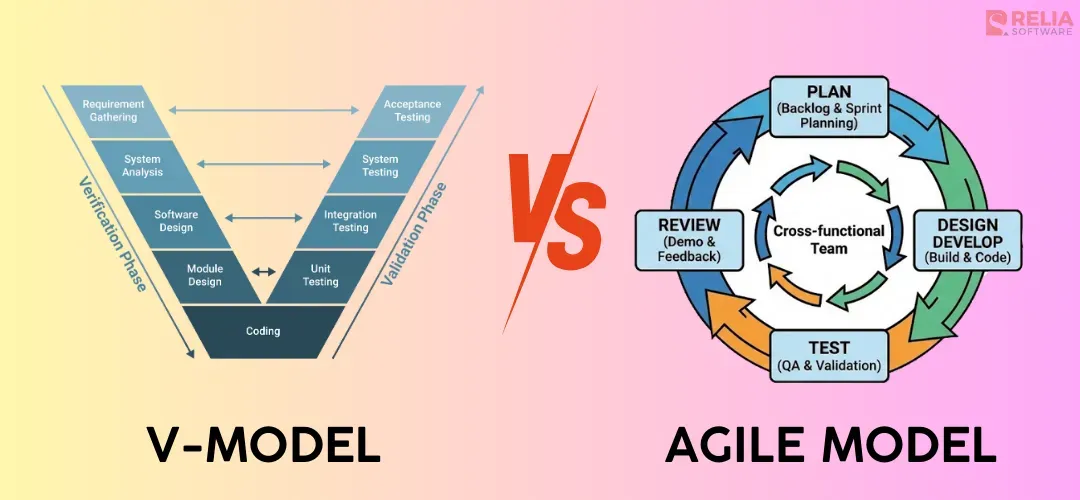Choosing between the V-Model and Agile is a choice between predictability and flexibility. V-Model follows a fixed plan where all requirements are decided early, giving teams a controlled path with few changes. Agile takes a different approach by building the product in small steps and adjusting the work as new needs appear.
To better understand these two approaches, this guide compares how the V-Model and Agile handle requirements, design, and testing, so you can decide whether your project needs the V-Model’s structured approach or Agile’s fast, iterative way of working.
>> Read more: 8 Common Software Development Life Cycle (SDLC) Methodologies
Aspects | V-Model | Agile Model |
Approach | Based on the Verification and Validation model | Uses iterative cycles to build and deploy software |
Requirements | Set at the beginning and rarely changed | Changing requirements based on feedback |
Design | Full design created before coding starts | Design grows and improves during the project |
Development | Testing starts only when the coding is finished | Coding and testing happen at the same time |
Customer Involvement | Customer provides requirements at the start and feedback at the end | The customer gives feedback every few weeks |
Cost of Change | High | Low |
Documentation | Heavy documentation required | Light documentation, created when useful |
Risk Handling | Reduces risk by strict planning | Reduces risk by testing ideas quickly |
Best For | Stable, regulated, safety-critical projects | Fast-moving digital products and apps |
Delivery | Single product delivery at the very end of the project | Continuous delivery in small increments after every sprint |
Key Differences Between V-Model and Agile In Software Development Lifecycle (SDLC)
Approach
V-Model uses a clear "Verification and Validation" structure. The first half of the project focuses on defining what the system should do, and the second half checks whether the product matches those requirements. Testing only starts after the coding is completed, which creates a strict, step-by-step workflow, making the final product match the original plan closely.
Agile takes a different approach by working in short and repeated cycles. Each cycle includes planning, coding, and testing, and ends with a working piece of software. Instead of waiting until the end, Agile teams validate their work every few weeks. This helps them make quick adjustments based on real user feedback, not just written documents.
>> Read more: Difference between Verification and Validation in Software Testing
Planning Phase Requirements
All requirements in V-Model must be written in full detail before any coding begins. The team prepares an SRS that covers every feature, condition, and step the system must follow. Once this document is approved, it becomes fixed, and the team is expected to follow it without changes. This creates a stable plan but leaves little room for new ideas or updated needs.
In contrast, in Agile development, the team notes only what the user needs and decides the details later when it’s time to build that feature. For example, a simple note like “Users want to search for products” is enough at the start. When the team begins work, they choose how the search should function based on what makes sense for users at that time. This keeps the project flexible and responsive to new information.
>> Read more: Top 10 Agile Frameworks for Software Engineering
Model Architecture
In the V-Model, the system architecture is designed almost completely at the start. Because requirements are fixed early, the team can draw the full system structure, decide how modules connect, and plan technical details before coding begins. This gives everyone a stable blueprint to follow, but if a serious design mistake is found later, changing the architecture can be slow and expensive.
In Agile, the architecture grows step by step. The team starts with a simple, working core and then extends or reshapes the structure as new features are added. Developers refactor regularly to keep the design clean and flexible. This reduces the risk of over-design and helps the system adapt when user needs or priorities change.
Development & Testing
Developers and QA in a V-Model project work distinctly. Developers code what the document describes and then pass the work to QA once they are finished. QA comes in only after the development ends, focusing on checking whether the code matches the document, not whether it actually solves the user’s real problem. Because of this, a product can pass every test but may still fail to meet user needs.
Agile teams work much more closely. Coding and testing happen at the same time inside the sprint. A feature is finished only after both developers and QA agree it works, helping detect and prevent serious issues early. This shared workflow keeps problems smaller and easier to fix.
>> Read more: What is The Difference Between QA and QC in Software Testing?
Flexibility
V-Model projects handle unexpected changes very slowly. After the plan is set, adding a new feature requires a formal request, a review by a control group, and updates to several documents before anyone can start the code. This long path is meant to keep the project steady and prevent unexpected shifts.
Meanwhile, Agile makes changes faster. A new idea is placed in the backlog, discussed in refinement, and moved into a sprint if it’s important. Because Agile plans in short cycles, the team can adjust quickly without reworking large parts of the project. This keeps the cost of change low and helps the team respond faster to new needs.
Documentation
In V-Model projects, the team depends quite heavily on detailed documentation. Every requirement, design step, code change, and test must be connected so the team can show exactly why each part of the system exists. This is required in areas like medical or automotive software, where auditors need clear proof that the product follows safety rules.
Agile keeps documentation lighter. The team writes down what people need to understand the system, such as key decisions or how services communicate, but avoids long technical explanations that add little value. If a document helps the team in the future, they keep it. If not, they skip it to stay focused on real work.
Stakeholder Involvement
In V-Model projects, stakeholders help define the requirements at the start and review the final product at the end, but rarely supervise during the design and coding. They'll receive only the status updates during the process. This will limit the clients from changing their idea or having pop-up requirements.
Oppositely, Agile lets stakeholders be involved during the development process through regular sprint reviews. Every few weeks, the team will show the real working software for stakeholders to test the features in real life. Then, the clients can give feedback or add new ideas immediately. This keeps the product on track with current stakeholder needs.
Quality Management
In terms of quality management, V-Model focuses mainly on technical correctness and safety. All requirements are fixed early, and each one is tested in a strict order. The goal is to prove that every function works exactly as defined, so defects are caught before the system is used in real life. This approach fits safety-critical areas where failure can be dangerous.
In Agile, quality is strongly linked to customer value. The team delivers small parts of the product early and watches how users respond. If a feature is confusing, unused, or not helpful, they can change it or stop it quickly. This helps avoid spending time and money building “perfect” features that do not actually solve a real problem for users.
When to Choose the V-Model?
- Projects with strict safety rules: In these projects, every requirement must be traced, tested, and approved, making the V-Model a strong fit because it provides full documentation and clear proof for audits.
- Projects with fixed requirements: When the features are already known and unlikely to change, the V-Model works well because the team can design everything up front without worrying about shifting priorities.
- Projects where failure is costly or dangerous: Systems like medical firmware, braking software, or flight modules need predictable behavior, and the V-Model reduces risk by verifying every requirement step by step.
- Projects driven by industry standards: When the work must follow a strict standard, the V-Model helps by matching the design and tests to the standard from the start.
- Projects inside organizations with heavy QA processes: Teams that depend on formal reviews, structured handoffs, and detailed test plans benefit from the V-Model because it fits their existing workflow.
- Projects tied closely to fixed hardware: Firmware or embedded software with unchanging hardware needs the V-Model’s upfront planning to avoid late design changes that could break the system.
When to Choose Agile?
- Projects that need fast delivery: When early releases are important, Agile helps by delivering small, working parts of the product quickly so users can try them right away.
- Projects focused on user experience: In these cases, frequent feedback is essential, and Agile’s short cycles make it easy to adjust designs and workflows based on real user reactions.
- Projects where market fit is uncertain: For products that may or may not match user needs, Agile reduces risk by testing ideas early so the team doesn’t waste time on features users won’t value.
- Projects that require ongoing experimentation: These projects need room to explore different solutions, and Agile supports this by allowing quick changes during each sprint.
- Projects with active stakeholder involvement: When stakeholders can join reviews regularly, Agile helps align the team’s work with current needs through direct, frequent feedback.
- Projects with flexible scope or budget: Agile fits these projects well because the team can shift priorities often, add or remove features, and adjust the plan as the project evolves.

FAQs
1. Can V-Model be Agile?
No, they are fundamentally different. The V-Model depends on fixed requirements, while Agile expects things to change as the team learns more. Some companies use a Hybrid model, in which V-Model is used for planning and compliance, and Agile sprints are used for the coding work.
2. Is the V-Model the same as Waterfall?
No, they are similar but not the same. Both follow a step-by-step process and make changes hard. The difference is in testing. Waterfall tests only at the end, while the V-Model connects each development step with a matching testing step from the start.
3. Why is Agile more popular today?
Because teams need to move fast. Agile lets them release early versions, gather feedback, and adjust quickly. The V-Model takes more time, and many digital products cannot wait for a long, fixed process in the current highly competitive software world.
>> Read more:
- V-Model vs Waterfall: Differences & Typical Use Cases
- Agile vs Waterfall Methodology: Similarities, Differences & Use Cases
- Lean vs Agile: Choosing the Right Approach for Software Projects
- DevOps vs Agile: What’s the Difference & How They Combine?
Conclusion
In conclusion, the V-Model is suitable when the requirements are clear, the work must follow strict rules, and every step needs documentation. Agile works better when plans change often, and early feedback is important. The final decision depends on how stable your requirements are, how quickly things may change, and how much risk your project can tolerate.
>>> Follow and Contact Relia Software for more information!
- Web application Development
- development
- web development

